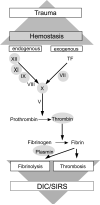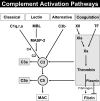Interaction between the coagulation and complement system
- PMID: 19025115
- PMCID: PMC2713875
- DOI: 10.1007/978-0-387-78952-1_6
Interaction between the coagulation and complement system
Abstract
The complement system as a main column of innate immunity and the coagulation system as a main column in hemostasis undergo massive activation early after injury. Interactions between the two cascades have often been proposed but the precise molecular pathways of this interplay are still in the dark. To elucidate the mechanisms involved, the effects of various coagulation factors on complement activation and generation of anaphylatoxins were investigated and summarized in the light of the latest literature. Own in vitro findings suggest, that the coagulation factors FXa, FXIa and plasmin may cleave both C5 and C3, and robustly generate C5a and C3a (as detected by immunoblotting and ELISA). The produced anaphylatoxins were found to be biologically active as shown by a dose-dependent chemotactic response of neutrophils and HMC-1 cells, respectively. Thrombin did not only cleave C5 (Huber-Lang et al. 2006) but also in vitro-generated C3a when incubated with native C3. The plasmin-induced cleavage activity could be dose-dependently blocked by the serine protease inhibitor aprotinin and leupeptine. These findings suggest that various serine proteases belonging to the coagulation system are able to activate the complement cascade independently of the established pathways. Moreover, functional C5a and C3a are generated, both of which are known to be crucially involved in the inflammatory response.
Figures


References
-
- Bernard GR, Vincent JL, Laterre PF, LaRosa SP, Dhainaut JF, Lopez-Rodriguez A, Steingrub JS, Garber GE, Helterbrand JD, Ely EW, Fisher CJ. Efficacy and safety of recombinant human activated protein C for severe sepsis. N Engl J Med. 2001;344:699–709. - PubMed
-
- Campbell W, Okada N, Okada H. Caboxypeptidase R is an inactivator of complement-derived inflammatory peptides and an inhibitor of fibrinolysis. Immunol Rev. 2001;180:162–167. - PubMed
-
- Choi G, Schultz MJ, Levi M, van der Poll T. The relationship between inflammation and the coagulation system. Swiss Med Wkly. 2006;136:139–144. - PubMed
-
- Davis AE., III Biological effects of C1 inhibitor. Drug News Pespect. 2004;17:439–446. - PubMed
-
- Fruchterman TM, Spain DA, Wilson MA, Harris PD, Garrison RN. Complement inhibition prevents gut ischemia and endothelial cell dysfunction after hemorrhage/resuscitation. Surgery. 1998;124:782–791. - PubMed
Publication types
MeSH terms
Substances
Grants and funding
LinkOut - more resources
Full Text Sources
Other Literature Sources
Molecular Biology Databases
Miscellaneous

